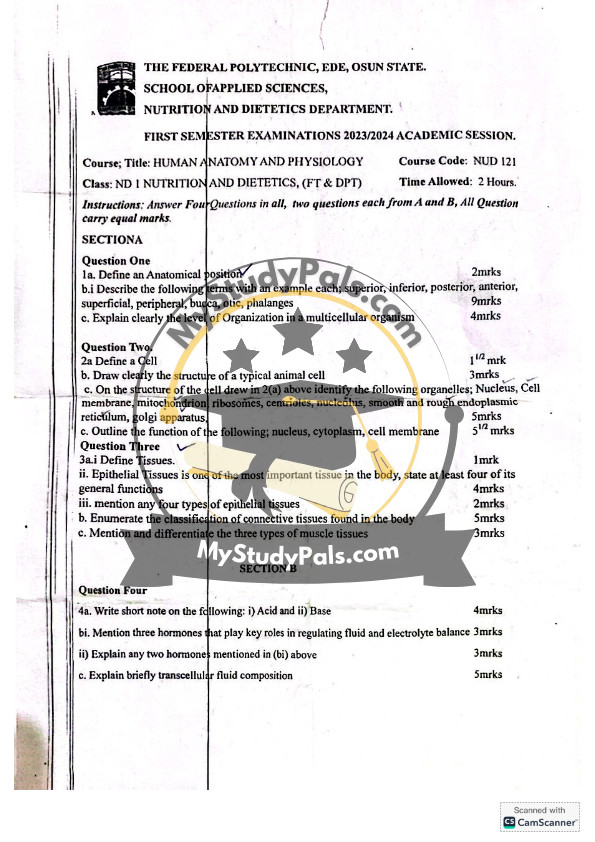ANWSER
Question One:
a. Define an anatomical position.
Answer: Anatomical position refers to the standard position of the body used as a reference in anatomy. It involves standing upright, facing forward, feet together, arms at the sides with palms facing forward.
b. Describe the following terms with an example each:
- Superior: Refers to a position above another structure. Example: The head is superior to the chest.
- Inferior: Refers to a position below another structure. Example: The stomach is inferior to the heart.
- Posterior: Refers to the back side of the body. Example: The spine is posterior to the ribs.
- Anterior: Refers to the front side of the body. Example: The nose is anterior to the ears.
- Superficial: Refers to a structure closer to the surface of the body. Example: The skin is superficial to the muscles.
- Peripheral: Refers to structures away from the center of the body. Example: The fingers are peripheral to the shoulder.
- Buccal: Relates to the cheek area. Example: The buccal cavity is located inside the mouth.
- Otic: Relates to the ear. Example: The otic region is where the ears are located.
- Phalanges: Refers to the bones of the fingers and toes. Example: The phalanges are part of the skeletal system.
c. Explain clearly the level of organization in a multicellular organism.
Answer: The levels of organization in a multicellular organism are:
- Cellular Level – The basic unit of life, such as muscle cells or nerve cells.
- Tissue Level – A group of similar cells performing a common function, e.g., epithelial tissue.
- Organ Level – Different tissues working together to form organs like the heart or liver.
- Organ System Level – A group of organs that work together, e.g., the digestive system.
- Organism Level – The complete living being, e.g., a human.
Question Two:
a. Define a cell.
Answer: A cell is the basic structural, functional, and biological unit of all living organisms, capable of performing all life processes.
b. Draw clearly the structure of a typical animal cell.
(Diagram Required)
c. On the structure of the cell drawn in (2a) above, identify the following organelles:
- Nucleus – The control center of the cell, containing DNA.
- Cell membrane – A semi-permeable barrier that surrounds the cell.
- Mitochondrion – The powerhouse of the cell, responsible for energy production.
- Ribosomes – Sites of protein synthesis.
- Centrioles – Involved in cell division.
- Nucleolus – Located within the nucleus, involved in ribosome production.
- Smooth Endoplasmic Reticulum (SER) – Involved in lipid synthesis and detoxification.
- Rough Endoplasmic Reticulum (RER) – Studded with ribosomes and involved in protein synthesis.
- Golgi Apparatus – Modifies, sorts, and packages proteins for secretion.
d. Outline the function of the following:
- Nucleus – Stores genetic material and controls cell activities.
- Cytoplasm – A gel-like substance that houses organelles and facilitates cellular processes.
- Cell Membrane – Regulates the movement of substances in and out of the cell.
Question Three:
a. Define tissues.
Answer: Tissues are groups of similar cells that work together to perform a specific function.
i. Epithelial tissues are one of the most important tissues in the body. State at least four of its general functions.
- Protection – Forms a barrier against mechanical and microbial harm.
- Absorption – Helps in the absorption of nutrients in the intestines.
- Secretion – Produces mucus, enzymes, and hormones.
- Excretion – Helps remove waste products from the body.
ii. Mention any four types of epithelial tissues.
- Simple squamous epithelium
- Simple cuboidal epithelium
- Stratified squamous epithelium
- Pseudostratified columnar epithelium
iii. Enumerate the classification of connective tissues found in the body.
- Loose connective tissue (e.g., areolar tissue)
- Dense connective tissue (e.g., tendons and ligaments)
- Cartilage (e.g., hyaline cartilage)
- Bone (osseous tissue)
- Blood (fluid connective tissue)
c. Mention and differentiate the three types of muscle tissues.
- Skeletal Muscle: Voluntary, striated, and responsible for body movement.
- Cardiac Muscle: Involuntary, striated, found only in the heart, and responsible for pumping blood.
- Smooth Muscle: Involuntary, non-striated, found in organs like the stomach and intestines, and responsible for peristalsis.
Question Four:
a. Write a short note on the following:
i) Acid
Answer: An acid is a substance that releases hydrogen ions (H⁺) in solution, making the pH lower than 7. Examples include hydrochloric acid (HCl) in the stomach.
ii) Base
Answer: A base is a substance that releases hydroxide ions (OH⁻) in solution or accepts hydrogen ions, making the pH higher than 7. Examples include sodium hydroxide (NaOH) and bicarbonates in blood.
b. Mention three hormones that play key roles in regulating fluid and electrolyte balance.
- Aldosterone – Regulates sodium and potassium balance in the kidneys.
- Antidiuretic Hormone (ADH) – Controls water retention in the kidneys.
- Atrial Natriuretic Peptide (ANP) – Reduces sodium and water retention, lowering blood pressure.
ii. Explain any two hormones mentioned in (b) above.
- Aldosterone: Produced by the adrenal glands, aldosterone promotes sodium retention and potassium excretion, affecting blood pressure and fluid balance.
- ADH (Antidiuretic Hormone): Secreted by the hypothalamus, ADH increases water reabsorption in the kidneys to prevent dehydration.
c. Explain briefly transcellular fluid composition.
Answer: Transcellular fluid is a small portion of extracellular fluid found in specific compartments such as cerebrospinal fluid, synovial fluid in joints, pleural fluid, and peritoneal fluid. It serves as a lubricant and provides cushioning for organs.


